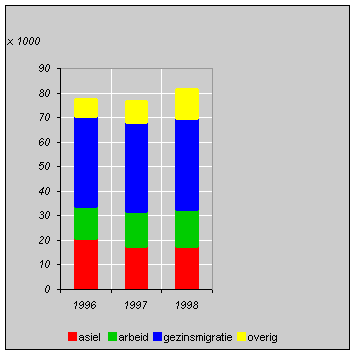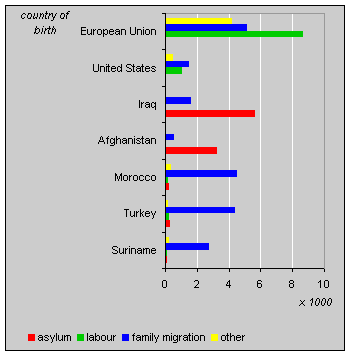Why do immigrants come to the Netherlands?

The number of immigrants in the Netherlands has risen sharply since 1995. In 2000 130 thousand people arrived here. In 1998, 122 thousand immigrants entered the Netherlands, including 82 thousand people with non-Dutch nationalities.
The most important category of non-Dutch immigrants are refugees, labour migrants and reuniting family members. One quarter of non-Dutch immigrants come from countries in the European Union.
Family migration
Nearly half of non-Dutch immigrants come to the Netherlands with their family or join someone who is already here. In 1998, 37 thousand people migrated with their partners, rejoined their families or formed a family with a non-Dutch partner. Turks and Moroccans in particular marry partners from the country of origin or reunite with their families. The number of family reunionists of asylum migrants rose strongly in the nineties. In 1998 there were just as many family reunionists from Iraq as from Turkey or Morocco, nearly 1,600.
Motives of non-Dutch immigrants, 1996-1998

Labour migration
In 1998, 15,300 people came to the Netherlands for work-related reasons. Recent labour migrants mostly come from west European and other affluent countries such as the United States. Nearly half of immigrants from European countries come here to work. The increase in labour migration from outside the EU was much stronger: it rose by 40% between 1996 and 1998.
Motives by country of birth, 1998

Asylum
In 1998 17,300 asylumseekers came to the Netherlands, nearly 9 thousand from Iraq and Afghanistan. Family members of asylum seekers usually arrive one year later. In 1998 6,600 of these follow-on migrants,of whom 4,700 family reunionists and 1,900 family formers arrived in the Netherlands. This means that one in three non-Dutch immigrants arriving in the Netherlands came to seek asylum or to rejoin someone seeking asylum.
Han Nicolaas and Arno Sprangers